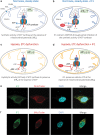The Multifaceted ATPase Inhibitory Factor 1 (IF1) in Energy Metabolism Reprogramming and Mitochondrial Dysfunction: A New Player in Age-Associated Disorders?
- PMID: 34605675
- PMCID: PMC9398489
- DOI: 10.1089/ars.2021.0137
The Multifaceted ATPase Inhibitory Factor 1 (IF1) in Energy Metabolism Reprogramming and Mitochondrial Dysfunction: A New Player in Age-Associated Disorders?
Abstract
Significance: The mitochondrial oxidative phosphorylation (OXPHOS) system, comprising the electron transport chain and ATP synthase, generates membrane potential, drives ATP synthesis, governs energy metabolism, and maintains redox balance. OXPHOS dysfunction is associated with a plethora of diseases ranging from rare inherited disorders to common conditions, including diabetes, cancer, neurodegenerative diseases, as well as aging. There has been great interest in studying regulators of OXPHOS. Among these, ATPase inhibitory factor 1 (IF1) is an endogenous inhibitor of ATP synthase that has long been thought to avoid the consumption of cellular ATP when ATP synthase acts as an ATP hydrolysis enzyme. Recent Advances: Recent data indicate that IF1 inhibits ATP synthesis and is involved in a multitude of mitochondrial-related functions, such as mitochondrial quality control, energy metabolism, redox balance, and cell fate. IF1 also inhibits the ATPase activity of cell-surface ATP synthase, and it is used as a cardiovascular disease biomarker. Critical Issues: Although recent data have led to a paradigm shift regarding IF1 functions, these have been poorly studied in entire organisms and in different organs. The understanding of the cellular biology of IF1 is, therefore, still limited. The aim of this review was to provide an overview of the current understanding of the role of IF1 in mitochondrial functions, health, and diseases. Future Directions: Further investigations of IF1 functions at the cell, organ, and whole-organism levels and in different pathophysiological conditions will help decipher the controversies surrounding its involvement in mitochondrial function and could unveil therapeutic strategies in human pathology. Antioxid. Redox Signal. 37, 370-393.
Keywords: ATP synthase; IF1; cardiovascular disease; energy metabolism reprogramming; mitochondrial dysfunction; oxidative stress.
Conflict of interest statement
No competing financial interests exist.
Figures






References
-
- Asmann YW, Stump CS, Short KR, Coenen-Schimke JM, Guo ZK, Bigelow ML, and Nair KS. Skeletal muscle mitochondrial functions, mitochondrial DNA copy numbers, and gene transcript profiles in type 2 diabetic and nondiabetic subjects at equal levels of low or high insulin and euglycemia. Diabetes 55: 3309–3319, 2006. - PubMed
-
- Bae TJ, Kim MS, Kim JW, Kim BW, Choo HJ, Lee JW, Kim KB, Lee CS, Kim JH, Chang SY, Kang CY, Lee SW, and Ko YG. Lipid raft proteome reveals ATP synthase complex in the cell surface. Proteomics 4: 3536–3548, 2004. - PubMed
Publication types
MeSH terms
Substances
LinkOut - more resources
Full Text Sources
